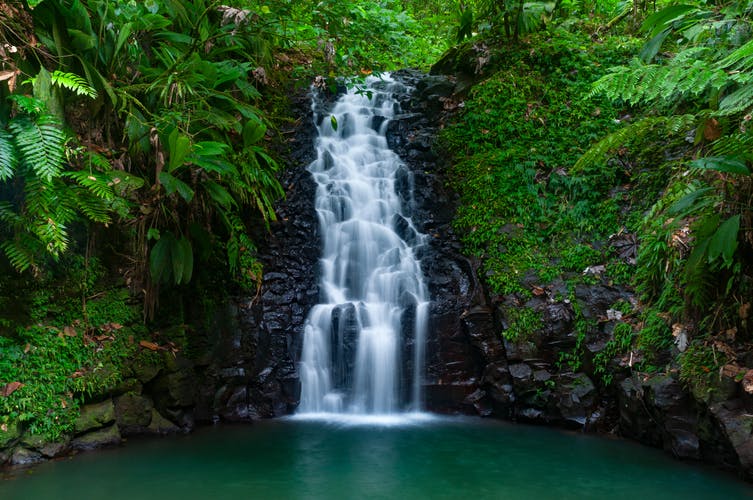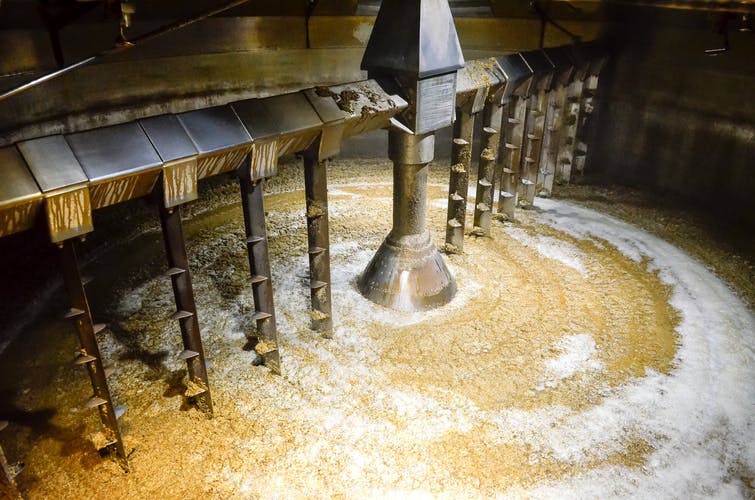
Whether it flows over granite, limestone, or quartz; whether it comes from turbulent rivers, peat-filled lochs, or crystalline springs; whether it is acidic, rich in salts or iron, the existence of a natural reserve of pure and abundant water has always been a determining factor in the location of distilleries.
All of them swear by the quality of their water and claim its influence on the aromas of their whisky.
The nature of water
Water first appears in the form of rain and snow. If it falls on crystalline rocks, the water will flow quickly and not come into contact with underground layers. Low in minerals, it retains its softness and a slight acidity. This type of water is the most common in Scotland.
When in contact with more permeable soil or sedimentary rock (such as limestone or sandstone), the water penetrates the underground and becomes enriched with minerals, carbonates, and sulfates. It then becomes alkaline and hard. The famous Glenmorangie distillery, located in the northern Highlands, is one of the few to have such a water source.
For many distillers, soft water flowing over granite through peat is considered the best for production. Of the more than 145 distilleries still in operation, fewer than twenty have a water source with such properties, notably Balblair, located less than four kilometers from Glenmorangie.
Mashing in whisky
Water plays a role at several stages of production: during malting, the barley is moistened to allow it to germinate; during distillation, the cold water in the condensers turns the alcohol vapors into liquid; finally, water is used during the dilution of the whisky before bottling.
However, it is primarily the key element added during mashing. The crushed malt (grist), mixed with hot water, is stirred to extract the soluble starch. This mixture usually consists of one part grist to four parts of water. Mashing takes place in a generally enclosed vessel, made of steel, cast iron, or wood (such as Oregon pine), called a mash tun, which is equipped with rotating blades and a perforated steel bottom.

Three successive waters are necessary to extract the sugars from the malt. The first water, which corresponds to the third water from the previous mash, is heated between 60°C and 65°C.
Beyond this temperature, diastase, the malt enzyme responsible for converting starches into sugars (maltose, dextrin), dies. This substance is essential for the development of the aromatic palette of whiskies, particularly the esters responsible for fruity and floral aromas.
The resulting liquid, a sweet wort, called wort, flows through the mash tun and is stored in an intermediate vessel, the underback. A second water, heated between 70°C and 75°C, helps extract the remaining sugars from the malt. The resulting sweet wort joins the underback. Finally, a third extraction water, called sparge, heated between 80°C and 85°C, will be used for the next mash. The residual grist, the draff, rich in proteins, is intended for livestock.
The flavors of water
Of the four elements necessary for whisky production, water is undoubtedly the most difficult to measure in terms of its impact on aromas.
However, the flavors of the water are generally reflected in the character of the whisky. The schematic classification of single malts based on their region of origin—Lowlands, Highlands, Speyside, and Islay—partly relies on a geological reality, with water being the main vector.
On the island of Islay, each distillery has its own source. Bunnahabhain uses fresh, clear water sourced from deep springs. For Bowmore, this precious water flows from the vigorous Laggan River, acquiring a light hue. Ardbeg, Caol Ila, Lagavulin, and Laphroaig draw water from deep lochs.

In Speyside, the water, similar in texture, is both clearer and fresher. This region, home to the most renowned distilleries, sits on a geological formation primarily composed of quartz and granite. As the snow melts, the water flows through fertile soil covered by coniferous forests (pine, fir).
Thus, at Macallan or Glenlivet, the water carries notes of pine needle, moss, and birch wood.
From north to south and east to west, the water of the Highlands is characterized by a great diversity. In the northeast, the Glenmorangie distillery uses water that flows over porous rocks composed of limestone and sandstone.
The water used in whisky production varies by region and can influence certain aspects of the process, particularly fermentation.
In the northern Highlands, the water is typically hard and low in peat, which is often associated with structured whiskies such as Ben Nevis, Dalmore, or Glen Garioch. In the southern part of the region, it flows through limestone and sandstone formations, as well as soils covered with vegetation like ferns and heather. Whiskies produced in this area, such as Aberfeldy, Blair Athol, or Edradour, are sometimes described as fresh and spicy.
In the Lowlands, the water now comes from natural reservoirs located in the surrounding hills and passes through sandstone, volcanic rocks, and former coal deposits. This water, often described as soft and low in minerals, is used by distilleries like Auchentoshan, Bladnoch, and Glenkinchie, as well as those on the Isle of Arran and in Campbeltown.
Water: An invaluable resource for whisky production
While water constitutes a small part of a whisky's aromatic palette, it remains an invaluable resource. Distilleries, subject to the whims of the seasons, have learned to respect the natural water cycle.
Each year, to prevent excessive depletion of their source, they observe a so-called "dry" period during which production is halted. Therefore, it is not surprising that each distillery fiercely protects the supply and quality of a resource that is both so fragile and unpredictable.
TO EXPLORE WHISKIES FURTHER
La Maison du Whisky has three boutiques in Paris:
In each of these boutiques, you'll find a wide selection of whiskies, rums, sakes, and other fine spirits.
Because a whisky can be described in a thousand words, our experts will be delighted to guide you through the must-try whiskies at La Maison du Whisky.
Follow our tasting calendar for upcoming events, or visit the Golden Promise Whisky Bar, which offers an extensive selection of whiskies and other spirits by the glass.
Written by
- Quentin JEZEQUEL - SEO project manager at LMDW.
Verified by
- Didier GHORBANZADEH - Wine & Spirits Expert at LMDW
- Clotilde NOUAILHAT - Editorial and Corporate Communications Manager at LMDW